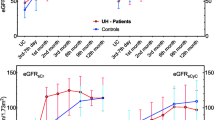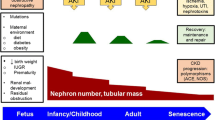Abstract
Purpose
The cornerstone of management in newborns with ureteropelvic junction obstruction (UPJO) is serial imaging over time. Surgery is undertaken for disease progression. A marker of disease progression would select out those likely to progress for early surgery and diminish the intensity of imaging and follow-up in the remainder. Recently, urinary proteome analysis in the newborn has been reported to fulfill this aim. The objective of this study is to quantitatively evaluate the effect of this matrix of protein biomarkers on the overall cost-effectiveness (C-E) of UPJO evaluation and management.
Methods
A Markov process decision tree model (Tree Age Pro software, Boston, MA) is created to compare the current strategy (watchful waiting) to one incorporating a urine proteome analysis at birth as a marker of disease progression. The analysis includes the costs of surgery, imaging and office visits based on hospital charge data. We analyze a total of 53 variables.
Results
The incorporation of this marker of progression results on the average, in an incremental C-E gain of $8,000 per quality adjusted life year (QALY) per patient compared to the current strategy of watchful waiting. The results are not sensitive to variation of any of the probabilities including costs and quality of life parameters used for the base-case analysis.
Conclusions
The incorporation of urinary proteome analysis in the initial evaluation of UPJO significantly reduces costs and increases the QALYs in this patient population. The test increases the odds of detecting UPJO progression from 1:3 to 1:1, while improving the overall C-E. These findings justify continued research in this area which in addition may have important applications in evaluating treatment outcomes.


Similar content being viewed by others
References
Dhillon HK (1998) Prenatally diagnosed hydronephrosis: the Great Ormond Street experience. BJU 81(2):39–44
Ulman I, Jayanthi VR, Koff SA (2000) The long-term follow-up of newborns with severe unilateral hydronephrosis initially managed nonoperatively. J Urol 164:1101–1105
Fernbach SK, Maizels M, Conway JJ (1993) Ultrasound grading of hydronephrosis: introduction to the system used by the Society for Fetal Urology. Pediatr Radiol 23:478–480
Palmer LS, Maizels M, Cartwright PC et al (1998) Surgery versus observation for managing obstructive grade 3 to 4 unilateral hydronephrosis: a report from the Society for Fetal Urology. J Urol 159:222–228
Ransley PG, Dhillon HK, Gordon I, Duffy PG, Dillon J, Barratt TM (1990) The postnatal management of hydronephrosis diagnosed by prenatal ultrasound. J Urol 144:584
Hsieh MH, Meng MV (2007) Decision analysis and Markov modeling in urology. J Urol 178:1867–1874
Mesrobian H-G (2005) Best strategy for evaluation and management of hydronephrosis in newborns and infants: a cost-effectiveness analysis based approach. Medical College of Wisconsin Library. Dissertation submitted to the faculty of the graduate school of Biomedical Sciences
Birth Data from the National Center for Health Statistics (2003) vol 52 (10)
Fefer S, Ellsworth P (2006) Prenatal hydronephrosis. Pediatr Clin North Am 53:429–447
Decramer S, Bascands J-L, Schanstra JP (2007) Non-invasive markers of ureteropelvic junction obstruction. World J Urol 25:457–465
Tengs TO, Wallace A (2000) One thousand health-related quality of life estimates. Medical Care (38):583–637
Drummond MF (1996) Guidelines for authors and peer reviewers of economic submission to the BMJ. BMJ 313:275–283
Conflict of interest ststement
There is no conflict of interest.
Author information
Authors and Affiliations
Corresponding author
Rights and permissions
About this article
Cite this article
Mesrobian, HG.O. The value of newborn urinary proteome analysis in the evaluation and management of ureteropelvic junction obstruction: a cost-effectiveness study. World J Urol 27, 379–383 (2009). https://doi.org/10.1007/s00345-008-0355-z
Received:
Accepted:
Published:
Issue Date:
DOI: https://doi.org/10.1007/s00345-008-0355-z




